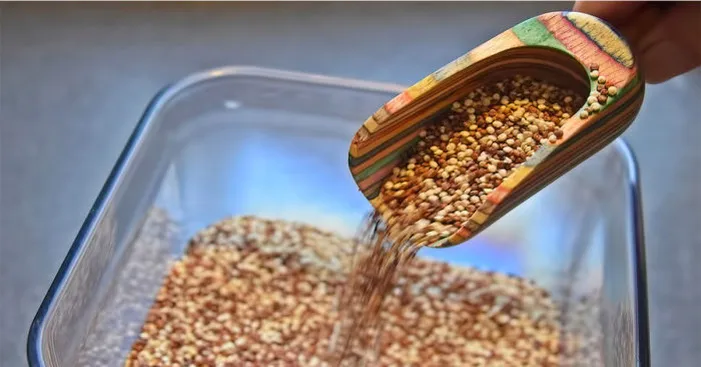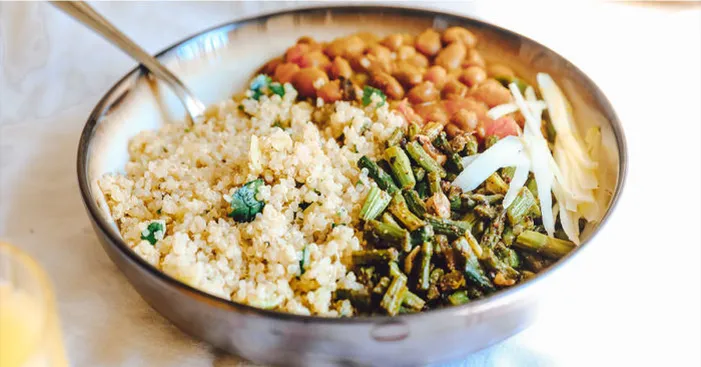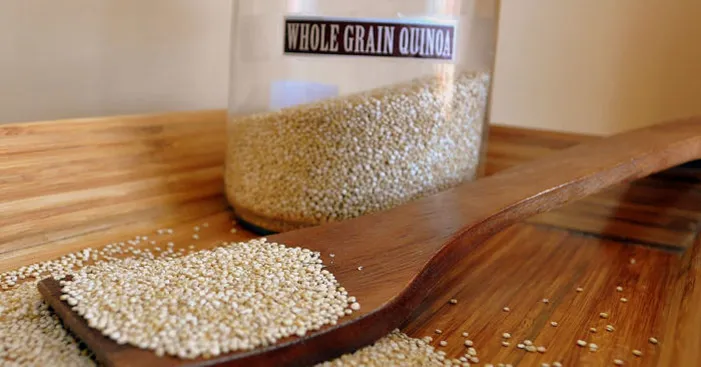Table of Contents
Quinoa seeds are highly nutritious but still not very famous in kitchens and recipes around the world.
However, people recently become aware of its large list of benefits and especially vegetarians who rely on it to provide calcium and other essential nutrients.
In this article, we gathered all the useful information about quinoa seeds’ benefits, the difference between ordinary cereals and quinoa seeds, and the precautions you need to know before you start consuming these super seeds.
General facts about quinoa seeds:
Quinoa seeds and cereals:
Quinoa seeds are often wrongly considered cereals when in fact they are among the vegetables.
This seed doesn’t belong to the Poaceae cereal family instead it is among the Chenopodiaceae botanic family and is a close relative to spinach and beets. (1) (2)
However, they have very similar nutritional values to cereals which is why they are referred to as “pseudocereals” along with buckwheat and amaranth. (3)
The plant lives in harsh inhospitable environments and resists very well to cold and wind.
Originally, quinoa seeds come from South America but thanks to their good nutritional reputation farms around the world grow them nowadays.
For instance, this plant produces crunchy little seeds which can be found in two types:
Sweet quinoa seeds: these are natural seeds that have been washed to remove the saponin coating.
Bitter quinoa seeds: these are natural seeds that have not been processed and still have saponin, a plant chemical that tastes bitter.
Quinoa seeds types:

Flakes: these are the most known form of quinoa as you only need to hydrate them with milk to obtain a nutritious “pseudo-cereal” boll or use them to make muffins and pancakes.
Chips: You can also find chips made from quinoa which makes them healthier than regular chips.
Flour: This could be a great substitute for wheat flour especially for people who want to make gluten-free cakes, biscuits …
Milk: Same as hemp milk or soy milk, quinoa milk is rich in micro-nutrients and perfect for milkshakes or just drinking it on its own as it tastes delicious.
How many quinoa seeds should a person eat?

On average, a serving is about 3 ounces (85g) of quinoa seeds enough to make a dish for one person. (4)
This is because quinoa seeds grow larger in weight when you cook them which is why 3 ounces of raw quinoa seeds become 12 ounces of cooked quinoa. (5)
You can put in mind that ½ cup (3ounces) of cooked quinoa offers about 120 calories, 4.5g of protein, 21g of carbs, 15g of fats, and 2.8g of fibers.
Benefits of quinoa seeds:

Encourages weight loss:
To lose weight we need fewer fats and calories in comparison to the calories we intake.
In general, starchy food may as well help in a slimming diet because they are low in fats and rich in complex carbs.
More particularly, this applies to quinoa seeds as they do offer a good amount of carbs and fibers with a moderate amount of saturated fats.
To help burn more calories than we intake, certain foods can increase metabolism and there are other types of foods that reduce the appetite.
Once we consume quinoa seeds, we feel fuller and that is because of their high fiber content which also limits the absorption of fats and sugars.
In addition, a good amount of proteins also help maintain muscle mass and ensure that the lost weight is mainly from body fats.
Also, quinoa seeds are very low in glycemic index and their consumption doesn’t influence blood sugar levels or insulin. (6)
There are currently not enough studies to confirm the effects of quinoa seeds in reducing body weight
Nonetheless, quinoa seeds seem to have all the needed micronutrients that help in a weight-loss diet.
Gluten-free seeds:
For people with gluten intolerance (gluten-sensitive or celiac disease), the only way to treat the disease is by banning gluten sources in the diet.
Nutritionists and doctors advise their patients to consume gluten-free food instead of cereals that are high in gluten. (7)
This is where quinoa seeds come in handy as they can be a great replacement for gluten cereals.
In fact, you can use/cook quinoa the same way you use gluten cereals such as oats, wheat, barley …
Coming from the same family as beets and spinach, quinoa seeds are not related to cereals which is why it differs from them in terms of nutritional values.
Because of that, quinoa seeds are completely safe for people who are suffering from gluten sensitivity or those who follow a gluten-free diet. (8)
However, there are some proteins in quinoa seeds that could trigger an auto-immune response that seems like an allergy, we will explain this more in the next part.
Prevents diabetes:
A certain group of researchers at the University of Brazil studied different types of beans and seeds to find out which ones are more capable of preventing diabetes. (9)
They found that quinoa seeds:
- Can control type 2 diabetes as well as the associated blood pressure.
- Have better antioxidant properties compared to most of the beans and seeds.
In addition, another study on mice conducted by the Plant Foods for Human Rights Purposes in 2010 showed that quinoa seeds can:
- Reduce glucose levels thanks to some of its plant compounds that can control the function of alpha–glycosidase.
- Delay the absorption of sugar thanks to its high carbs content, therefore slows the release of glucose in the bloodstream.
- Positively impact blood sugar levels.
Cancer:
A 2017 study published in the Journal of the science of food and agriculture confirmed that quinoa seeds contain Lunasin which has anti-cancerous effects. (10)
There was another study in 2017 in the International Journal of Macroeconomics shows that Polysaccharides in quinoa seeds can reduce the risk of cancer. (11)
Improves heart health:
Quinoa seeds offer fatty acids, high-quality proteins, carbs, and antioxidants.
Combined, these micro-nutrients are very beneficial for the heart as they can reduce the level of bad cholesterol and reduce the risk of cardiovascular diseases.
Some studies conclude that moderate consumption of quinoa seeds for both the elderly and the young population lowers the risk of heart diseases. (12)
Other beneficial facts about quinoa seeds:
Quinoa seeds are among the types of food that are a complete source of essential nutrients including water, carbs, protein, fibers, minerals, and vitamins.
Because of their richness in most of what the body needs, people can count on these seeds to provide their daily needs from nutrition.
In fact, NASA chose quinoa seeds as a primary food for their astronauts since they don’t occupy a big volume and they offer the essential nutrients outside of space. (13)
Quinoa seeds also offer a good amount of dietary fibers which are needed by the digestive system to treat constipation and diarrhea.
These seeds contain all the amino acids to supply the body with energy.
Many athletics consume quinoa seeds 1 to 2 hours before they do their practices in order to increase their physical activity and double their effort.
Quinoa contains a wide list of minerals including magnesium, calcium, and other important minerals that help our bodies deal with health issues.
For instance, magnesium from quinoa seeds reduces stress/anxiousness and muscles contraction which helps relax.
On the other hand, calcium in quinoa seeds helps maintain bone density which results in healthier bone structure and less vulnerability to breaks.
Also, many studies on quinoa seeds show that they may reduce depression and oxidative stress by healing damaged brain cells.
Furthermore, quinoa seeds offer many vitamins such as vitamin E, B1, B3, B6 as well as omega 3 fatty acids which all contribute to better health.
All of those nutrients in these tiny seeds ensure a better immunity against many diseases such as osteoarthritis, Alzheimer‘s, cancer, diabetes…
In addition, quinoa seeds protect the liver membrane and cells from damage which means a lower risk of hepatitis.
Precautions before you consume quinoa seeds:

Allergy to saponin:
Quinoa seeds are naturally coated with a chemical compound called saponin. (14)
This substance exists as a foamy coat on each seed and helps protect it from germs and parasites.
However, some groups of people can experience allergic reactions once they ingest saponin from raw unwashed quinoa seeds.
Risk of kidney stones:
Quinoa seeds also contain oxalate which is a plant compound that is also known as acetic acid and can bind to calcium which results in a higher risk of developing kidney stones.
Therefore, it is very crucial to avoid the consumption of quinoa seeds especially for those who already deal with kidney stones or osteoporosis. (15)
Nonetheless, by boiling and soaking quinoa seeds we can reduce the amount of the oxalate content by more than 85%.
Allergy to some proteins in quinoa seeds:
Some people may experience an allergic reaction due to some types of proteins in quinoa seeds and the symptoms may be as follow: (16)
- Coughing and respiratory infection.
- Shortness of breath.
- Swelling of the tongue and difficulties swallowing.
- Vomiting and nausea.
- Abdominal pain.
- Itching and skin rash.
Other extreme symptoms (post-traumatic stress) that occurs rarely could be:
- Acceleration of the heartbeats.
- A sudden drop in blood pressure.
- Anaphylactic reaction.
In this extreme allergic reaction, it is crucial to get the person hospitalized as soon as possible as the situation may be life-threatening.
References:
(1): list of plants in the family Poaceae | Britannica
(2): Chenopodiaceae: Goosefoot Family. Identify plants, flowers, and shrubs (wildflowers-and-weeds.com)
(3): 11 Types Of Pseudocereal That You Can Add To Your Diet | Food For Net
(4): Quinoa Rice Nutrition | Livestrong.com
(5): Basic Quinoa Recipe – Skinnytaste
(6): Quinoa & the Glycemic Index | Livestrong.com
(7): Dietary Changes for Celiac Disease | Johns Hopkins Medicine
(8): Gastrointestinal effects of eating quinoa (Chenopodium quinoa Willd.) in celiac patients – PubMed (nih.gov)
(9): Effects of sprouted and fermented quinoa (Chenopodium quinoa) on glycemic index of diet and biochemical parameters of blood of Wistar rats fed high carbohydrate diet (nih.gov)
(10): Detection of lunasin in quinoa (Chenopodium quinoa Willd.) and the in vitro evaluation of its antioxidant and anti-inflammatory activities – PubMed (nih.gov)
(11): Chemical characterization, antioxidant, immune-regulating and anticancer activities of a novel bioactive polysaccharide from Chenopodium quinoa seeds – PubMed (nih.gov)
(12): Quinoa (Chenopodium quinoa Willd.): Exploring a Superfood from Andean Indigenous Cultures with Potential to Reduce Cardiovascular Disease (CVD) Risk Markers – PubMed (nih.gov)
(13): Quinoa has reached NASA but is becoming inaccessible for Andean consumers (worldbank.org)
(14): What’s the Deal with Saponins? – Quinta Quinoa
(15): 73682_PE_Choosing_whole_grains_for_kidney_stone_prevention_Mar21_2017_V1.pdf (andornot.com)
(16): Quinoa allergy: Symptoms and alternatives (medicalnewstoday.com)

